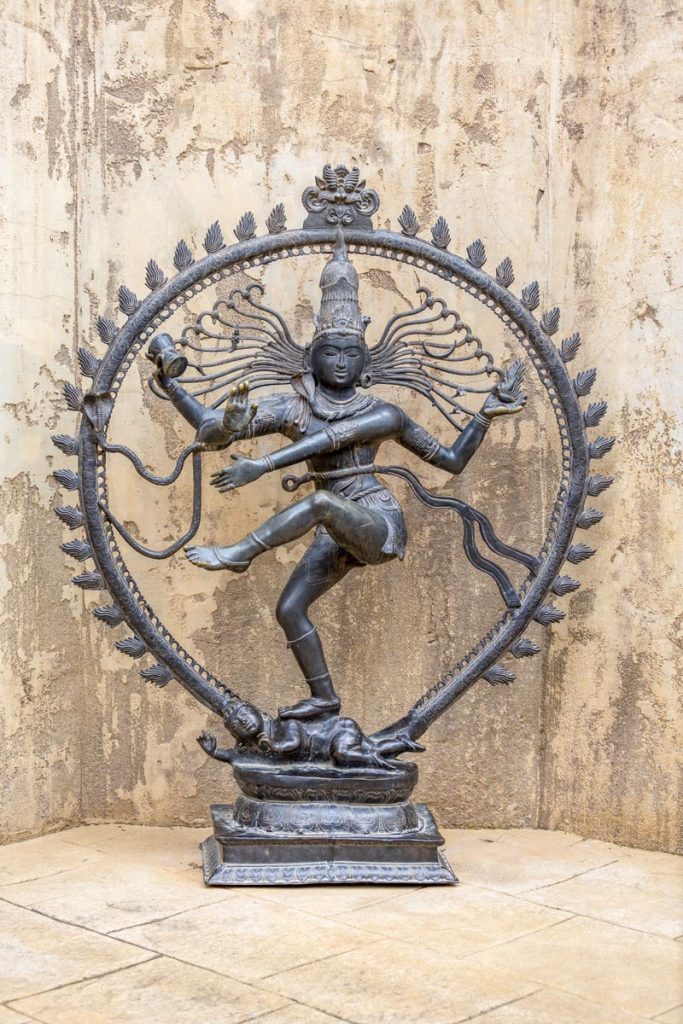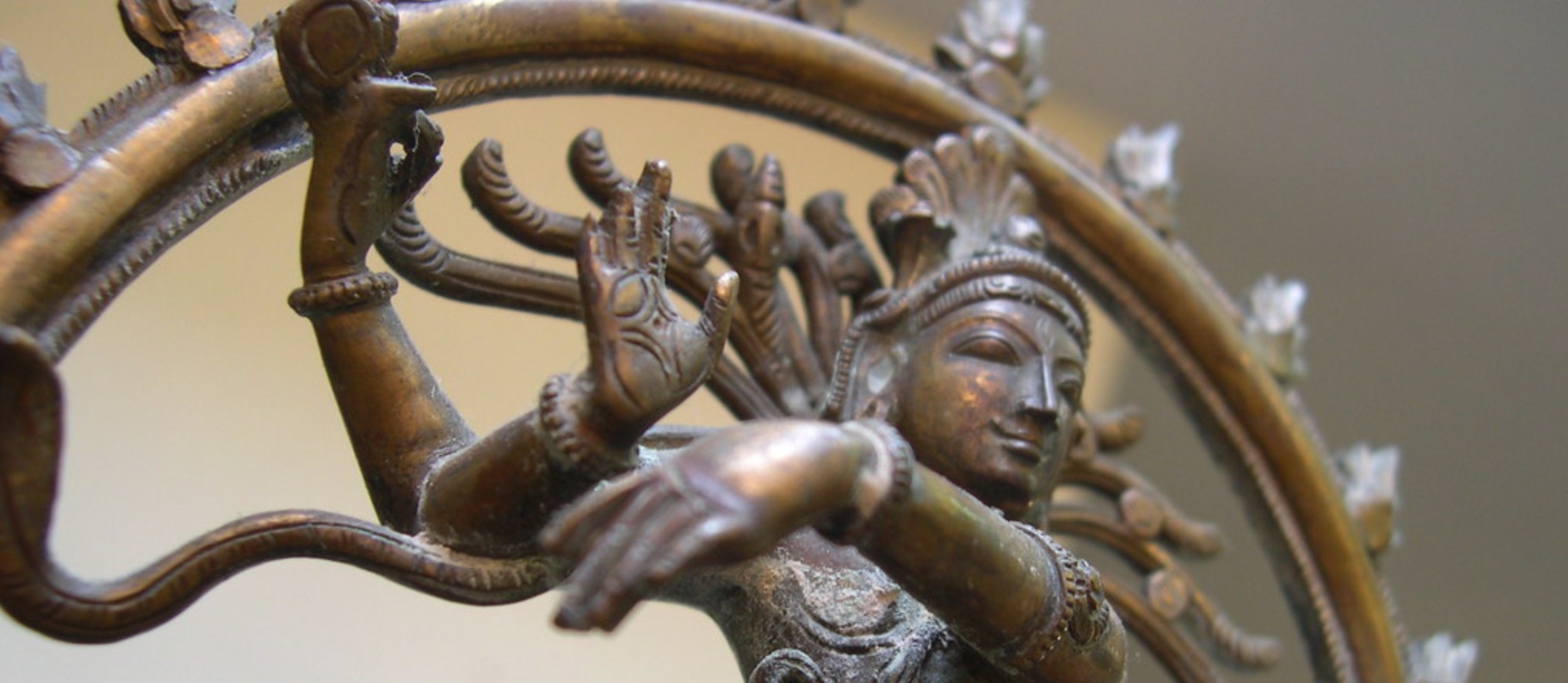How Lord Nataraja’s Divine Inspiration Helped Me Embrace Dance and Transform My Entire Life
By Savita Tiwari, Mauritius
Many forms of siva are loved and revered by His devotees. The Sivalingam is perhaps the most celebrated and ancient form; others include Ardhanarishvara, Bhairava, Pashupati and Dakshinamurti. Nataraja—Siva as the cosmic dancer—is naturally the form most worshiped by performing artists.


Nataraja created the universe with His dance. He is like a cloud filled with water waiting to unleash the thunderstorm, or the firm light of a lamp in a place with no air movement. In this form, Siva is the center of the world. Just as an atom dances in its orbit, the universe is dancing in the cosmic orbit of Nataraja. In Nataraja form, Siva is the master of all dance enthusiasts, with the universe as His stage, performing His life-giving dance for the world.
The word Nataraja translates as “the king of acts” or “king of dance.” Devi Sarasvati is the Goddess of creativity, knowledge, music and wisdom. Writers, singers and anyone from the creative fields who follow Hinduism pray to Goddess Sarasvati for blessings and success. But for dancers, especially Indian classical dancers, Nataraja is God. One will find Nataraja’s image in the logo of many dance academies and displayed on classical dance competition posters. His divine statue graces the altar of myriad performers.
After reading about Nataraja in a few books and blogs, I turned to the primary source of knowledge, our scriptures. A shloka in Ashtadhyayi by Sage Panini: “At the end of His cosmic dance, Nataraja, the Lord of Dance, with a view to bless the sages Sanaka and others, played His damaru (drum of creation) 14 times (first nine times and then five times), from which emerged the 14 sutras, popularly known as the Siva Sutras or Maheshvara Sutras.” Based on these 14 sutras, Mahapandit Panini recorded his grammar of Sanskrit—Ashtadhyayi—and thus the mother of all languages was encapsulated.
Every human being can interpret Nataraja according to their level of consciousness. Some say Nataraja represents cosmic dance. Some say He represents destruction and creation. For some, this form is the manifestation of Siva’s shakti. For some it is grammar. For me, however deep I went, Nataraja simply remains king of dance.
The dance of Nataraja is called Ananda Tandava. His pose is described in detail in scriptures such as the Anshumadbhed Agama and Uttarakamika Agama. Four-handed, Nataraja holds a damaru (drum) in one hand and Agni (fire) in the another. A third hand is in abhayamudra, gesturing “fear not, ”and the fourth points towards His raised foot. Damaru is the representation of the akasha tattva—space element. It is nada, the sound of Aum, said to be the beginning of the universe. Agni is the fire element, which represents pure knowledge, as it burns all material things, leaving only the eternal.
Personally, I relate every element of Nataraja’s symbolism to dance. Damaru is music, and fire is the energy needed for dance. Abhayamudra is a blessing to the performer, and the hand pointing downward is prithivi tattva, which is needed for balance. The circle of fire around Nataraja is the border of the dance platform. The small person named Apasmara beneath the Lord’s feet is the ego of the dancer. The raised leg stands for leaping confidently towards perfection.
I decided to learn dance to understand Nataraja more fully. It wasn’t an easy decision for a full-time writer and mother of two young kids with a busy priest husband. But I was inwardly drawn to dance, revering it like so many who follow the Hindu path. It is common to see statues of our Gods in dance poses, such Ganesha, Siva, Radha-Krishna and Durga. Our Gods dance, and so can we. Until now, dancing was limited to clapping for others. Now, I would move beyond clapping and join the performance.
There were nine classical dance forms from which to choose. I chose Kathak dance because of easy access to an online guru, and because, as a writer, I like to tell stories, and Kathak originated from Katha, storytelling. Once I started learning, it became clear I was on a path of spiritual growth and not merely learning a classical dance form. Each time I danced, I felt connected to the unknown. To say that Kathak elevated me to a new level would be cliche, but those words are true to my core.
My first lesson was to hold strong the position called utpatti, meaning “origin,” the stance from which all movements begin and end. For some, utpatti can be home, for some it can be a person who feels like home. For me, utpatti is the strong hold of Mother Earth—Bhoomi Devi assuring me to dance without fear of falling, as She will always be there to catch me.
In Kathak, the utpatti position is also called sam, which means “even.” This reminds me of India’s most important Nataraja temple, Chidambaram Thillai Nataraja-Koothan Kovil, which is situated directly on the magnetic equator, making it appear free of any magnetic force from north or south. Similarly, in utpatti, is a place where we can balance ourselves, just like Nataraja.
Chidambaram is one of five holy sites of Sivalingam worship in South India that represent the five natural elements. Chidambaram Lingam is a small crystal that represents akasha tattva, or ether. This is also the only Siva temple in India where the dancer Siva in the form of Nataraja enjoys the full status of chief Deity. Whenever my dance teacher scolded me to keep my balance, I imagined myself on even ground at Chidambaram and was able to balance myself. Indeed, the importance of controlling my mind is the first lesson I learned. The second lesson is to complete my actions, to finish what I start, in every aspect of my life.


I am also on the path to subdue the personal ego, represented by the dwarf, Apasmara, under the right foot of Nataraja—who epitomes the greedy, possessive self. These qualities cannot be erased from the human heart but can be suppressed through spiritual wisdom. It is interesting to note that epilepsy, a brain condition that may cause seizures and sudden loss of consciousness, is called Apasmara in ayurveda. There is a Nataraja pose in yoga used to treat patients with epilepsy.
Dance now impacts all aspects of my life, how I express myself, how I carry myself and more. Forexample, I have completely stopped slouching. Initially, my teacher had to alert me whenever I slouched during class. But after six months my body aligned itself, and now I rarely slouch.
My passion for Kathak became the talk of get-togethers with family and friends. I was annoyed when they scoffed at classical music and dance performances. It was easy to forgive their ignorance, but it was also bothersome that they wanted me to show them some moves. I refused politely, but when they kept pressing I shared why that was not so simple. I explained that I must first pray to Lord Nataraja and then to Bhoomi Devi, for their blessings. Then I pray to the five elements, Pancha Tattva, my guiding angels during the dance. I must also show gratitude to my guru for teaching me this sacred art. Upon hearing this, they understood how serious and reverent I am about dance, and how it should be treated with great respect.
Now no one asks me to show them dance moves, but they are interested in what new life lessons I have learned from my dancing. There are many small but important things I have learned during my journey of exploring my inner Nataraja. For example, I don’t feel bad if I trip during practice in front of others. I just regain my bearings and resume where I left off. I have also improved my respiratory control. Then there is the strong bonding with the musicians, who keep you in sync. Inwardly they become my best friends, though we never get a chance to hang out. Dance has become my solace. If I am angry, I dance it out. If I am stressed, I dance it out. If I am happy, I dance it out. It’s my daily dose of pure spirituality.
My teacher compliments me for my commitment to the art, and commitment is the foremost requirement of learning these art forms. Although I don’t fish for praise, my teacher’s words warm my heart as a gentle reassurance that I can complete what I started.
The left side of the sanctum in Chidambaram Nataraja temple is concealed by a veil that is only removed on special occasions, and just for a few moments. Beyond the veil an empty space represents Siva in the form of akasha tattva. Legends say only the blessed ones understand this mystery (rahasya). I like to connect this chamber with the thousand-headed Adishesha who is ready to give individualistic knowledge to deserving students. Maybe someday I will be a good enough student to understand the rahasya. One day I will be able to pull the curtain of maya from my mind and see the real truth of life. Until then, I will continue my dance journey in front of Nataraja.
Dance has taught me how to move with fluidity, flexibility and stability. It has liberated me in the most fundamental way, helping me positively define and control my emotions and thoughts. I treasure the feeling of having an appreciative guru and classmates, the recitation of padhant, the completeness of a sum, the jugalbandi (duet) of tabla, the soothing and at the same time energizing sound of ghungroo, anklet bells. For the first time, with the chance and platform to express my stories and emotions, I feel my soul has a voice and is enjoying every single second of expressing itself.
Taking care of myself is not a task anymore, it is a lifestyle. Eating a regular balanced diet, carrying myself properly, and having a happy and empathetic mind has, I believe, made me a better person. It is said that life is simple until we complicate it. The same goes for dance—the first rule is to keep it simple.
I am eagerly awaiting the day I offer my first dance to Nataraja in a temple. Just like manas puja, I am going to offer nritya puja to my beloved Mahadev. I will offer flowers and fruits with my hand movements and will show my emotion with my eyes. And I will offer my devotion in the form of tears of happiness flowing down my cheeks. Imagining that day gives me immense happiness, just like Narayan imagining the Ananda Tandava of Nataraja. My journey toward finding Nataraja has begun with one giant step, and I have already seen the best changes in my life. I can’t wait to see what more I will encounter during this journey. Jai Nataraja!


